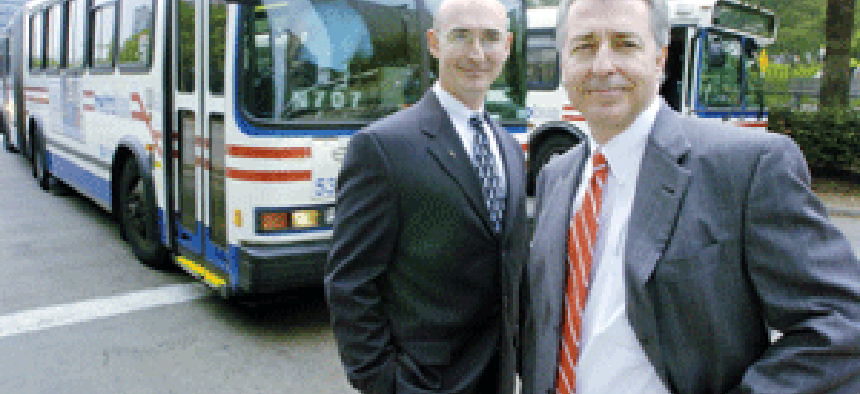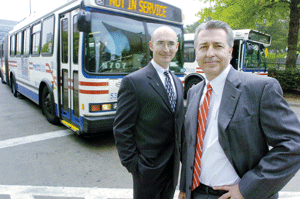IMS, Legato link truck stops to Transportation HQ

How does a federal agency ensure continuity of operations across all its offices when some of those offices are little more than a computer on a desk? That was the challenge facing the Transportation Department when it approached storage solutions integrator IMS Systems Inc. two years ago.
How does a federal agency ensure continuity of operations across all its offices when some of those offices are little more than a computer on a desk? That was the challenge facing the Transportation Department when it approached storage solutions integrator IMS Systems Inc. two years ago.The Federal Motor Carrier Safety Administration, one of 13 agencies in the Transportation Department, has more than 90 offices across the country. Its job is to reduce accidents involving trucks and buses through a series of programs, such as the Performance and Registration Information Systems Management program, which combines federal carrier safety records with state records.As a new agency, founded in 2000, FMCSA had yet to implement a comprehensive strategy for the continuity of operations when it turned to Silver Spring, Md.-based IMS in 2002."They needed an effective way to back up the data at all their offices, but because of what they do, many of those offices are freight and bus depots around the country," said Scott Carson, chief technology officer at IMS. "Some offices have data centers, but others are just a guy and a computer."This stumbling block to disaster recovery is one that IMS has begun to hear more about, Carson said. Agencies deploy IT personnel to far-flung sites, then must install backup systems and ensure that backup procedures are followed. For FMCSA, it was a cost-prohibitive option.IMS proposed what the storage industry has begun calling branch office consolidation, a solution that achieves continuity of operations on a budget, Carson said. Rather than back up data at FMCSA's 90 sites, an ad hoc process that previously involved several sites burning the occasional CD-ROM, IMS proposed mirroring all data from the field at TSA's Washington headquarters. Instead of running 90 backup operations, a single IT staff could implement just one."By having your central IT take care of data protection, you have the appropriate skills at the appropriate locations," Carson said.IMS proposed a branch office consolidation system built with applications from Legato Software, the Mountain View, Calif., division of storage vendor EMC Corp. Using Legato's RepliStor software at the agency's 90 sites, data is replicated on a server at Transportation headquarters in Washington. From there, the data is backed up using Legato's NetWorker software to a pair of Scalar 100 tape libraries from Advanced Digital Information Corp."There's definitely a move towards changing the backup model to use replication for consolidating information," said Kelly Polanski, Legato's vice president for availability products. "You move the data from production systems to a central site and then do the backup."According to Gartner Inc. of Stamford, Conn., the market for replication solutions is growing at more than 9 percent a year and will hit $1.8 billion in 2008."If there's been one obstacle to this model, it's been customers' concern about how much they'll have to spend on new network resources," Polanski said.But with FMCSA's 500GB converging on one data center, agency officials worried whether they had sufficient bandwidth. If 90 offices replicate data at the same time, it can hinder other traffic that needs to travel across the department's WAN. When Transportation described its requirements, managing bandwidth was high on its list, Carson said.RepliStor includes bandwidth traffic cop features that prevent the replication stream from hogging the network. Incremental backups, updating only new information instead of the whole database, can be specified from the central data center to reduce data traffic. IT staff can allocate how much bandwidth to use for replication and when to send the data. Carson said such "throttling" was important for Transportation , because the 90 FMCSA offices use a variety of connections to the WAN. "Some have T1 lines; others have dial-up connections," he said.By controlling what data is replicated and when, and how much bandwidth is used for replication, Polanski estimated agencies could move the same amount of data with about 20 percent of the bandwidth.By consolidating data on a server before backing up, branch offices can quickly and easily restore information by accessing the central server as a remote hard drive.Pushing the Legato solution out to all the offices took roughly six months, Carson said. For some offices, Transportation staff could install tools over the network, but others required onsite visits. The entire system was up and running by the end of last year.IMS President Ed Hartman said the solution cost TSA less than $300,000, a fraction of the cost of separate backups at 90 sites. He also said IMS, which derives about 80 percent of its almost $15 million in revenue from government customers, is planning to reproduce the solution for other agencies.If you have an innovative solution that you recently installed in a government agency, contact Staff Writer Brad Grimes at bgrimes@postnewsweektech.com.
 Replication software helps 90 offices operate as one
Replication software helps 90 offices operate as one

Scott Carson, chief technology officer, and Ed Hartman, president and CEO, of IMS Systems in Silver Spring, Md.
Laurie DeWitt
NEXT STORY: Doing business with the State Department

